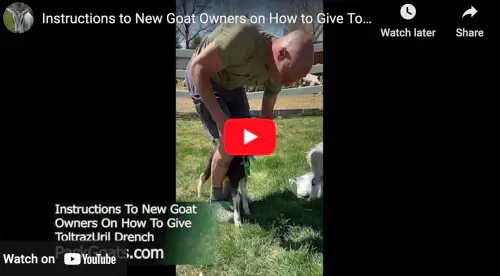New Goat Owners on How to Give Toltrazuril Drench
As a new goat owner, ensuring the health and well-being of your herd is a top priority. One common challenge faced by many goat keepers is the prevention and treatment of coccidiosis, a parasitic disease that can severely impact your animals. Toltrazuril, a widely trusted anti-coccidial medication, is highly effective in treating this disease. In this post, we’ll guide you through the proper steps for administering Toltrazuril drench to your goats, helping you keep them healthy and coccidiosis-free.
Why Toltrazuril is Important for Goats
Coccidiosis is caused by protozoan parasites (Eimeria species) and is most commonly seen in young goats. It can lead to diarrhea, dehydration, weight loss, and even death in severe cases. Toltrazuril is one of the most effective treatments available, as it works by disrupting the coccidian life cycle and preventing the spread of infection.
For new goat owners, learning how to correctly administer Toltrazuril is essential to maintaining herd health, especially during periods of stress or when young kids are most vulnerable.
Step-by-Step Guide to Administering Toltrazuril Drench
Administering a Toltrazuril drench is a simple but crucial process. Follow these steps carefully to ensure the correct dosage and application:
1. Gather Your Supplies
Before you start, make sure you have everything you need for the procedure:
- Toltrazuril solution (5% is commonly used for goats)
- A dosing syringe or drench gun
- A halter or assistant to help restrain the goat (if necessary)
- Gloves (optional, for hygiene)
2. Calculate the Proper Dosage
The standard dosage for Toltrazuril is typically 20 mg per kilogram (kg) of body weight. It’s essential to weigh your goat to determine the appropriate dosage. For example:
- For a 10 kg goat, the dosage would be 200 mg of Toltrazuril.
Always refer to the product label or consult with your veterinarian to ensure the correct dosage for your specific situation.
3. Prepare the Drench
Using your syringe or drench gun, draw up the calculated amount of Toltrazuril solution. Ensure that the syringe is free of air bubbles and accurately filled with the right amount of medication.
4. Restrain Your Goat
If your goat is calm, you may not need assistance, but for more energetic or nervous goats, it may be helpful to have someone hold the goat securely. You can gently restrain the goat by holding its head to keep it steady.
5. Administer the Drench
Insert the syringe into the side of the goat’s mouth, aiming toward the back of the tongue. Slowly administer the Toltrazuril solution, giving the goat time to swallow. Avoid administering the drench too quickly, as this may cause choking or spitting.
6. Monitor Your Goat
After administering the Toltrazuril, keep an eye on your goat to ensure it swallows the medication without any issues. Observe the animal for any adverse reactions, though these are rare when Toltrazuril is used correctly.
7. Repeat If Necessary
In most cases, a single dose of Toltrazuril is sufficient, but your veterinarian may recommend a follow-up treatment depending on the severity of the infection. Be sure to follow your vet’s guidance and monitor your goats for any recurring symptoms.
Preventing Coccidiosis in Goats
While Toltrazuril is an effective treatment, prevention is always better than cure. Here are some tips to help prevent coccidiosis in your goat herd:
- Keep your goat’s living area clean and dry.
- Avoid overcrowding to reduce stress and the spread of disease.
- Regularly deworm and monitor for signs of parasites.
- Ensure proper nutrition to keep your goats healthy and resilient.
Conclusion
For new goat owners, understanding how to administer Toltrazuril drench is a vital part of maintaining herd health. By following the instructions outlined above, you can effectively treat and prevent coccidiosis, keeping your goats happy and healthy. Always consult with a veterinarian for specific advice related to your herd and remember that consistent care is key to raising strong, thriving animals.
**This statement has not been evaluated by the Food and Drug Administration. This product is not intended to diagnose, treat, cure, or prevent any disease.**

